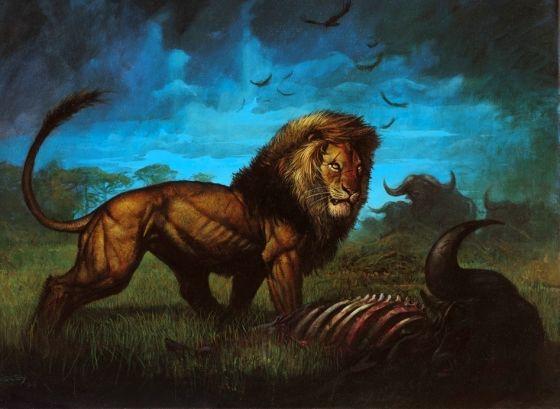Bestial Intelligence
Bestial Intelligence describes the mental actions and processes of creatures whose brains are insufficient to be measured as an ability statistic between 3 and 18. Previously this included creatures of "animal intelligence" or which were "semi-intelligent" — terms that no longer apply. In replacement, there are five grades of bestial intelligence: sensory, instinctive, belligerent, familial and cooperative. These grades are progressive, with sensory having the least cognitive ability and cooperative having the most.
Contents
The objective is to provide a framework for player-creature interactions, stressing the creature's motivation, the emotions it might possess and it's strategy when confronted or provoked. In combat, these animals fight by impulses derived from their hormones or conditioning. Higher thought only appears to exist, even where it's possible for the creature to "communicate" with those of higher intelligence — but this appearance is considered a delusion on the witness's part.
For some, it may be useful to think of bestial grades of intelligence equalling "zero" to "4" intelligence. There are issues with this, as explained under the intelligence stat. However, for the sake of convenience, a number has been attached to each grade as a memory aid. These numbers are used upon bestiary charts throughout the wiki.
Sensory Intelligence (0 pts.)
Zero intelligence creatures lack all self-awareness or emotion. Motivated by the need to eat and procreate, they react spontaneously to their environment, "sensing prey" when another creature is present. Most of these creatures are perpetually on the move, actively seeking prey, but some, like spiders, create traps that immobilise. According to their biological rhythms, these creatures will forgoe eating a victim in order to lay their eggs within it, to perpetuate their species. Usually the prey is eaten
- Encounters always initiate a death match between these creatures and prey. In combat, they fight until they're killed, without fear or comprehension of death.
- Attacking is utterly random, the creature flailing in every direction with its attacks and having an equal chance of targeting any adjacent creature.
Some forms of sensory creatures are highly social and occur in large numbers — like ants, wasps and bees. Encountering a single creature may initiate a call for others of the creature's kind; summoned through pheromones, these rush towards a threat and rapidly transform their number into a very dangerous swarm. However, since the swarm's concern is primarily to defend the nest, a rapid retreat — necessitating the desertion of fallen companions, who will be taken away and eaten — offers the best strategy.
